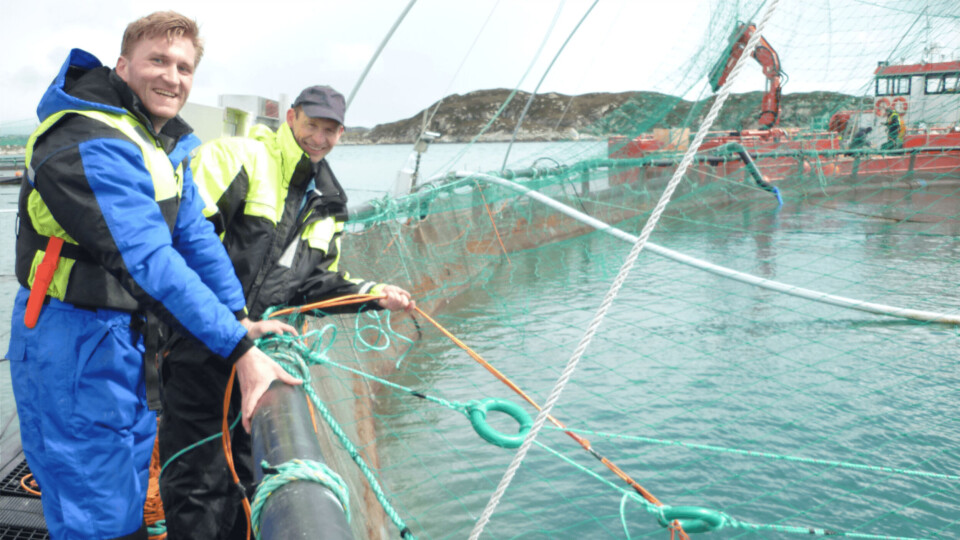
Machine learning ‘shows when to change smolt feeding’
An aquaculture tech company says it can now detect exactly when smolts are ready to change from continuous feeding to regular meals.
CageEye followed smolt behaviour in four cages over a period of 90 days at a commercial site located on the coast of Western Norway.
Behavioural analysis and machine learning algorithms enabled CageEye scientists to detect changes in behaviour and feeding responses that indicate smolt readiness for meal-based feeding regimes.

‘Smolt tell us’
“The smolt have always, in their own way, been trying to tell us when they’re hungry, but until now we’ve not understood what they’ve been saying,” said CageEye feeding specialist Mattis Severberg.
The company uses hydroacoustic sensors to observe the behaviour of smolts in sea cages, by monitoring how the biomass moves and schools. Data from the observations is processed using machine learning software.
Along with insight from expert fish biologists, the analysis makes it possible for farmers to understand the smolts’ needs, thereby determining exactly when preference is starting to change from continuous feeding to meal-based feeding.
Like feeding babies
“After transfer to seawater, smolt are often fed continuously: small amounts all day long. You can almost compare it to feeding babies,” said Severberg.
“When the farmer estimates that the fish has reached a certain weight, or after a given number of days at sea, the fish are considered ready for meal based feeding, a bit like how a baby would begin to eat in regular meals: breakfast, lunch and dinner. That’s when they change the feeding regime from feeding continuously, to feeding fewer, larger and separated meals.
“Now we have objective measurements and strong indicators of when it is the right time to make that change, based on actual fish behaviour, instead of using generic parameters such as weight or days in the sea.”

Timing is crucial
For fish farmers, it can be a challenge to get the transition between feeding regimes right, said CageEye in a press release.
“The first weeks and months of feeding after the smolt are transferred to sea are crucial for the growth and robustness of salmon during the rest of the production cycle,” said Øyvind Korsøen, a biological advisor in CageEye with a PhD in salmon behaviour.
“The goal is to start the transition when the fish are ready. You don’t want to start with fewer, separated meals too early, given that this risks underfeeding the fish and creating weight deviations if the fish are unable to capture sufficient feed pellets under such a regime.
“However, if you start too late, you risk higher feed waste and FCR (feed conversion ratio). To make it more complicated, the right time for the transition can differ from cage to cage on the same site.”
Four phases
The CageEye study found that smolt feeding preferences changed over time, starting with continuous feeding on transfer, and eventually moving to a preference for separated meals. The data confirmed that the populations under study went through roughly four phases after transfer to seawater, before being ready to move beyond “smolt feeding” to fewer, larger and separated meals.
Right after transfer to seawater the fish behaved more or less as they did prior to transfer, swimming high in the cage and staying close to the net during feeding hours, as if being automatically fed in the smolt facility.
In the first phase, fish got used to or habituated to living in a cage and started to explore their surroundings.
This was followed by a phase in which fish slowly became used to sunlight and started showing vertical movement in the cage at sunrise and sunset.
Clear responses
During the third phase, the fish began to show clear responses to the first meal-based feeding, and in the fourth and final phase, the fish were clearly indicating which meals they were most interested in.
CageEye said that with these insights, farmers can then respond to the smolts’ demonstrated preferences by moving to fewer, separated and more intense meals at exactly the right time.
The company said its technology provides the farmer with more control and the possibility to tailor feeding to realise the full growth potential of the fish. This in turn reduces costs, strengthening profitability. It also has the potential to reduce feed waste and improve welfare of the fish in the cage.
“We are on a good path here, as we have identified how farmers can optimise feeding regimes, and as we continue to perform more research and gather more data, we will continue to bring benefits to both fish and farmers,” said CageEye chief executive Bendik S Søvegjarto.






















































